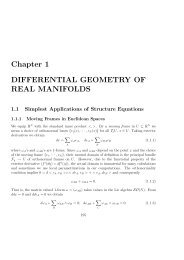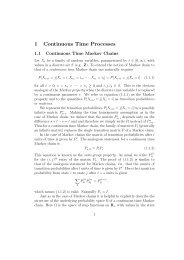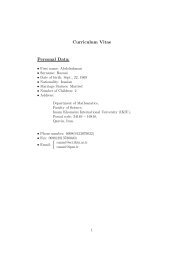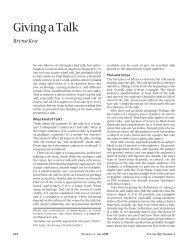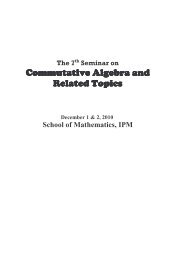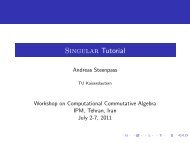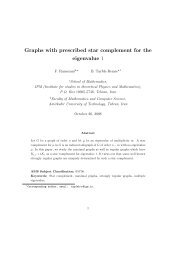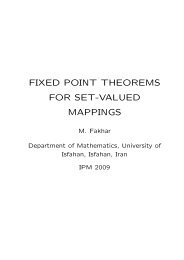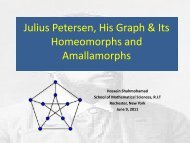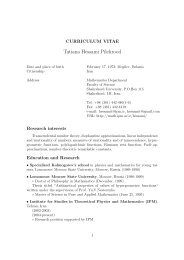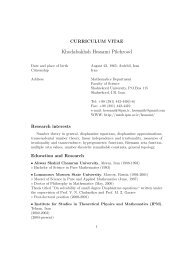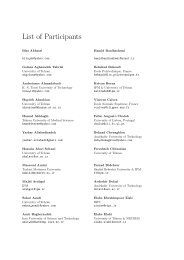A Workshop on Biomathematics - Math - IPM
A Workshop on Biomathematics - Math - IPM
A Workshop on Biomathematics - Math - IPM
You also want an ePaper? Increase the reach of your titles
YUMPU automatically turns print PDFs into web optimized ePapers that Google loves.
ﻲﺘﺴﻳﺯ ﺕﺎﻴﺿﺎﻳﺭ ﺭﺩ ﻲﺜﺣﺎﺒﻣ<br />
ﻱﺩﺎﻴﻨﺑﻱ ﺕﺎﻴﺿﺎﻳﺭﻩﺪﻜﺸﻫﻭﮋﭘ ﺎﻬﺸﻧﺍﺩﻩﺎﮕﺸﻫﻭﮋﭘ<br />
•<br />
-------------------------------------<br />
۱ ( ۷ ﻲﻟﺍ ۱۱ ﻩﺎﻣﻱﺩ ۱۳۸۹ ﻥﺎﮔﺪﻨﻨﻛﺭﺍﺰﮔﺮﺑﻲﻣﺎﺳﺍ : ﻱﺩﺎﻴﻨﺑﻱﺎﻬﺸﻧﺍﺩﻩﺎﮕﺸﻫﻭﮋﭘ،ﻲﻧﺎﻛﺮﺳﻮﺗﻪﺑﺯﻭﺭ ﻲﺷﺯﻮﻣﺁﻩﺎﮔﺭﺎﻛ )<br />
ﻱﺩﺎﻴﻨﺑﻱﺎﻬﺸﻧﺍﺩﻩﺎﮕﺸﻫﻭﮋﭘﻭﻒﻳﺮﺷﻲﺘﻌﻨﺻﻩﺎﮕﺸﻧﺍﺩ،ﻲﺳﺪﻘﻣﺎﺿﺭﺪﻴﺳ<br />
ﻱﺩﺎﻴﻨﺑﻱﺎﻬﺸﻧﺍﺩﻩﺎﮕﺸﻫﻭﮋﭘ،ﻥﺎﻴﺳﺎﺒﻋﻦﻴﺴﺤﻟﺍﺪﺒﻋ<br />
1<br />
•<br />
•
ﻱﺩﺎﻴﻨﺑﻱ ------------------------------------- ﺕﺎﻴﺿﺎﻳﺭﻩﺪﻜﺸﻫﻭﮋﭘ ۱ . ﻪﻣﺎﻧﺮﺑ ﺎﻫﻲﻧﺍﺮﻨﺨﺳ : ﻪﺒﻨﺷﻪﺳ۷ / ۱۰ / ۱۳۸۹ ﻪﺒﻨﺷﺭﺎﻬﭼ۸ / ۱۰ / ۱۳۸۹ ﻪﺒﻨﺷﺞﻨﭘ۹ / ۱۰ / ۱۳۸۹ ﻪﻌﻤﺟ۱۰ / ۱۰ / ۱۳۸۹ ﻪﺒﻨﺷ۱۱ / ۱۰ / ۱۳۸۹ ﺎﻬﺸﻧﺍﺩﻩﺎﮕﺸﻫﻭﮋﭘ<br />
- ۹:۰۰ ﻡﺎﻧﺖﺒﺛ ﺯﺍﺮﻓﺍﺵﺭﺁ ﻲﻣﺍﺮﻬﺑﺭﺩﺎﻬﺑ ﻱﺪﺳﺍﺮﻴﻣﺍ ﻲﻣﺍﺮﻬﺑﺭﺩﺎﻬﺑ ۱۰:۳۰ - ۱۰:۰۰ ﺲﻔﻨﺗ ﻲﻳﺍﺮﻳﺬﭘﻭﺲﻔﻨﺗ ﻭﺲﻔﻨﺗ ﻲﻳﺍﺮﻳﺬﭘ ﻭﺲﻔﻨﺗ ﻲﻳﺍﺮﻳﺬﭘ ﻲﻳﺍﺮﻳﺬﭘﻭﺲﻔﻨﺗ ۱۱:۳۰ - ۱۰:۳۰ ﺯﺍﺮﻓﺍﺵﺭﺁ ﻲﻣﺍﺮﻬﺑﺭﺩﺎﻬﺑ ﻱﺪﺳﺍﺮﻴﻣﺍ ﻥﺍﺩﺰﻳﺵﺭﺁ ﺶﺨﺑ ۱۰:۰۰<br />
- ۱۱:۳۰ ﺦﺳﺎﭘﻭﺶﺳﺮﭘ ﺦﺳﺎﭘﻭﺶﺳﺮﭘ ﺦﺳﺎﭘﻭﺶﺳﺮﭘ ﺦﺳﺎﭘﻭﺶﺳﺮﭘ ۱۴:۰۰ - ۱۲:۰۰ ﺭﺎﻬﻧ ﺭﺎﻬﻧ ﺭﺎﻬﻧ ﺭﺎﻬﻧ ﺭﺎﻬﻧ ۱۲:۰۰<br />
Introductio<br />
n to<br />
Memory<br />
Introductio<br />
n to<br />
Memory<br />
2<br />
Visi<strong>on</strong> Demo<br />
(Neur<strong>on</strong>al<br />
Spike-Train<br />
Analysis, A<br />
Case Study)<br />
- ۱۴:۰۰ ﺯﺍﺮﻓﺍﺵﺭﺁ ﻱﺩﻭﺭﺮﺳﺎﻳ) ﺲﻧﺍﺮﻔﻨﻛﻮﺋﺪﻳﻭ ( ﻥﺍﺩﺰﻳﺵﺭﺁ ﺶﺨﺑ ۱۶:۰۰ - ۱۵:۰۰ ﻱﺮﻳﺯﻭﻢﻳﺮﻣ ﻱﺩﻭﺭﺮﺳﺎﻳ) ﺲﻧﺍﺮﻔﻨﻛﻮﺋﺪﻳﻭ ( ﻥﺍﺩﺰﻳﺵﺭﺁ ﺶﺨﺑ ۱۶:۳۰ - ۱۶:۰۰ ﻭﺲﻔﻨﺗ ۱۵:۰۰ ﻲﻳﺍﺮﻳﺬﭘﻭﺲﻔﻨﺗ ﻲﻳﺍﺮﻳﺬﭘﻭﺲﻔﻨﺗ ۱۷:۳۰ - ۱۶:۳۰ ﻱﺮﻳﺯﻭﻢﻳﺮﻣ ﻲﻧﺍﺮﻨﺨﺳ ﻲﺋﻮﺠﺸﻧﺍﺩ ﻲﻧﺍﺮﻨﺨﺳ ﻲﻳﻮﺠﺸﻧﺍﺩ ﺍﺮﻨﺨﺳ ﻲﻧ ﻲﻳﻮﺠﺸﻧﺍﺩ ﻥﺍﺩﺰﻳﺵﺭﺁ ﺶﺨﺑ<br />
ﻲﻳﺍﺮﻳﺬﭘ
• Spatial limits of object processing in brain<br />
• Spatial heterogeneity in the percepti<strong>on</strong> of face and form attributes. A new<br />
theoretical approach to Translati<strong>on</strong> invariance<br />
• Physiological underpinnings of face representati<strong>on</strong> in the primate brain<br />
Abstract:<br />
The identity of an object is independent of where it appears in the visual field. According to<br />
<strong>on</strong>e of the classical tenets of the visi<strong>on</strong> science, the visual system captures this invariance.<br />
Large receptive fields of neur<strong>on</strong>s in the higher brain areas are believed to mediate this<br />
translati<strong>on</strong> invariance. Based <strong>on</strong> c<strong>on</strong>verging evidence from various experiments, many<br />
assumpti<strong>on</strong>s of this traditi<strong>on</strong>al view are challenged here. A series of experiments has<br />
dem<strong>on</strong>strated that translati<strong>on</strong> invariance and homogeneity of the visual percepti<strong>on</strong> are more<br />
pr<strong>on</strong>ounced for lower level visual features that are presumably encoded by neur<strong>on</strong>s with<br />
smaller receptive fields. Using “face adaptati<strong>on</strong>” paradigm, it is shown that the functi<strong>on</strong>al<br />
analysis regi<strong>on</strong> for face processing is much smaller than what has been thought. These results<br />
also show that face processing is based in retinotopic coordinates across head and eye<br />
movements. These new findings suggest a totally different doctrine for the more modestly<br />
named functi<strong>on</strong>; “translati<strong>on</strong> tolerance”. According to the new proposal, translati<strong>on</strong> tolerant<br />
object recogniti<strong>on</strong> is not necessarily the result of big receptive fields of neur<strong>on</strong>s in the higher<br />
brain areas. Translati<strong>on</strong> tolerance is perhaps a matter of learning, calibrati<strong>on</strong> and statistical<br />
ﻱﺩﺎﻴﻨﺑﻱ ------------------------------------- ﺕﺎﻴﺿﺎﻳﺭﻩﺪﻜﺸﻫﻭﮋﭘ ۲ . ﻦﻳﻭﺎﻨﻋ ﺎﻫﻲﻧﺍﺮﻨﺨﺳ : ﺵﺭﺁ ﺯﺍﺮﻓﺍ ، ﺎﻬﺸﻧﺍﺩﻩﺎﮕﺸﻫﻭﮋﭘ<br />
3<br />
ﻡﺍ . ﻱﺁ . ﻲﺗ . ﺎﻜﻳﺮﻣﺁ،ﺓﺪﻴﻜﭼﻭ<br />
sampling of separate object/feature selective units according to this new view.<br />
ﺎﻜﻳﺮﻣﺁ،ﻥﻮﺴﻳﺪﻣ<br />
• Biological complexity of gene networks: Towards a quantitative theory<br />
• Model reducti<strong>on</strong> in complete dynamical networks<br />
Abstract:<br />
Complex dynamical systems are ubiquitous. Major questi<strong>on</strong>s in biology, such as the origin of<br />
life and its evoluti<strong>on</strong> into uncountable forms and behaviors in living organisms have been<br />
investigated c<strong>on</strong>current with intellectual c<strong>on</strong>tributi<strong>on</strong>s to the science of complex systems. Our<br />
progress in understanding biological intelligence is tied to the depth and versatility of<br />
quantitative models of complex dynamics in the relevant organisms. Quantifying variati<strong>on</strong> in<br />
phenotypic and genotypic traits in organisms within a single genotype is regarded as the<br />
quintessential problem facing progress in understanding the nature and properties of the<br />
complex dynamics in biological systems.<br />
A novel view towards understanding variati<strong>on</strong> in traits is to regard variati<strong>on</strong> in phenotypic<br />
traits and diversity of the forms of behavioral resp<strong>on</strong>se to similar stimuli as results of many<br />
different forms of “Biological Computati<strong>on</strong>s” that take place in a biological system, despite all<br />
being qualified as “valid biological programs” for the “same set of genomic algorithms” that<br />
are encoded within a single genotype and stabilized through natural selecti<strong>on</strong> and other<br />
evoluti<strong>on</strong>ary mechanisms.<br />
-ﻦﻴﺴﻧﺎﻜﺴﻳﻭﻩﺎﮕﺸﻧﺍﺩ<br />
،ﻱﺪﺳﺍﺮﻴﻣﺍ
Thus, we are led to an old and challenging problem in theoretical biology, namely, to<br />
characterize Biological Computati<strong>on</strong> rigorously, and to develop the subsequent c<strong>on</strong>cepts that<br />
would lead to classificati<strong>on</strong> and descripti<strong>on</strong> of various forms of biological computati<strong>on</strong> that<br />
implement “computati<strong>on</strong>ally equivalent forms of genomic algorithms”. A magnificent example<br />
that brings together all the above menti<strong>on</strong>ed c<strong>on</strong>siderati<strong>on</strong>s is the animal brain. With no<br />
exaggerati<strong>on</strong>, the animal nervous system is the most studied complex dynamical system to<br />
date. The outstanding problem in neuroscience is notorious task of identifying brain activities<br />
and the animal behavior as emergent forms of biological computati<strong>on</strong>.<br />
A quantitative theory of Biological Complexity could be regarded as an essential step that<br />
provides insight into the biological nature of the types of events that comprise distinct cases of<br />
Biological Computati<strong>on</strong> that implement equivalent genomic algorithms, whether in brain or<br />
any other intelligent biological system. Thus, Biological Complexity could be regarded as the<br />
first systematic numerical measure of variati<strong>on</strong> of phenotypic traits in organisms within the<br />
same genotype.<br />
The first lecture lays out the biomolecular panorama for development of a computati<strong>on</strong>ally<br />
tractable theory of biological complexity. The sec<strong>on</strong>d lecture outlines the mathematical<br />
challenges that arise in extending such a theory from the molecular scale to the neur<strong>on</strong>al and<br />
behavioral domains.<br />
This research is a result of c<strong>on</strong>tributi<strong>on</strong>s by several students and collaborators in Iran and UW<br />
Madis<strong>on</strong>. ، ﻥﺎﺘﺴﻠﮕﻧﺍ ﻲﻣﺍﺮﻬﺑﺭﺩﺎﻬﺑ<br />
ﻱﺩﺎﻴﻨﺑﻱ ------------------------------------- ﺕﺎﻴﺿﺎﻳﺭﻩﺪﻜﺸﻫﻭﮋﭘ ﺎﻬﺸﻧﺍﺩﻩﺎﮕﺸﻫﻭﮋﭘ<br />
4<br />
،.<br />
ﻝﺍ<br />
ﻲﺳ ﻮﻳ . .<br />
• Individual differences in human behavior and the relati<strong>on</strong>ship to brain structure I, II<br />
Abstract:<br />
Human Parietal Cortex Structure Predicts Individual Differences in Perceptual Rivalry<br />
When visual input has c<strong>on</strong>flicting interpretati<strong>on</strong>s, c<strong>on</strong>scious percepti<strong>on</strong> can alternate<br />
sp<strong>on</strong>taneously between competing interpretati<strong>on</strong>s. There is a large amount of unexplained<br />
variability between individuals in the rate of such sp<strong>on</strong>taneous alternati<strong>on</strong>s in percepti<strong>on</strong>. We<br />
hypothesized that variability in perceptual rivalry might be reflected in individual differences<br />
in brain structure, because brain structure can exhibit systematic relati<strong>on</strong>ships with an<br />
individual's cognitive experiences and skills. To test this noti<strong>on</strong>, we examined in a large group<br />
of individuals how cortical thickness, local gray-matter density, and local white-matter<br />
integrity correlate with individuals' alternati<strong>on</strong> rate for a bistable, rotating structure-frommoti<strong>on</strong><br />
stimulus. All of these macroscopic measures of brain structure c<strong>on</strong>sistently revealed<br />
that the structure of bilateral superior parietal lobes (SPL) could account for interindividual<br />
variability in perceptual alternati<strong>on</strong> rate. Furthermore, we examined whether the bilateral SPL<br />
regi<strong>on</strong>s play a causal role in the rate of perceptual alternati<strong>on</strong>s by using transcranial magnetic<br />
stimulati<strong>on</strong> (TMS) and found that transient disrupti<strong>on</strong> of these areas indeed decreases the rate<br />
of perceptual alternati<strong>on</strong>s. These findings dem<strong>on</strong>strate a direct relati<strong>on</strong>ship between structure<br />
of SPL and individuals' perceptual switch rate.<br />
Reference: Ryota Kanai, Bahador Bahrami, Geraint Rees. Human Parietal Cortex Structure<br />
Predicts Individual Differences in Perceptual Rivalry. Current Biology - 28 September 2010<br />
(Vol. 20, Issue 18, pp. 1626-1630)
• Collective decisi<strong>on</strong>-making<br />
Abstract:<br />
How to "see" the elephant in the dark: social interacti<strong>on</strong> afford reliable belief formati<strong>on</strong> even in<br />
the absence of objective knowledge<br />
Sensory percepti<strong>on</strong> is noisy and incomplete. Therefore, our beliefs about physical events that<br />
give rise to percepti<strong>on</strong> have limited reliability. This limitati<strong>on</strong> is beautifully portraied by Rumi<br />
in the story of "the elephant in the dark": each observer's descripti<strong>on</strong> of the elephant is far from<br />
the truth and severely c<strong>on</strong>strained by his limited sensory sample. Rumi c<strong>on</strong>cluded that "light"<br />
(ie external source of objective knowledge) is necessary for formati<strong>on</strong> of a reliable belief. In<br />
my talk I will challenge this noti<strong>on</strong> and provide empirical evidence arguing that if Rumi's<br />
protag<strong>on</strong>ists had talked to each other and shared their experience via social interacti<strong>on</strong>, they<br />
could have come to a descripti<strong>on</strong> of the elephant as accurate as if they had had access to light. I<br />
will also discuss the implicati<strong>on</strong>s of this finding for social learning in different cultural<br />
c<strong>on</strong>texts by comparing European and Chinese observers.<br />
Reference: Bahrami, B., Olsen, K., Latham, P. E., Roepstorff, A., Rees, G., Frith, C. D.<br />
(2010). Optimally interacting minds. Science, 329 (5995). 1081-1085<br />
ﻱﺩﺎﻴﻨﺑﻱ ------------------------------------- ﺕﺎﻴﺿﺎﻳﺭﻩﺪﻜﺸﻫﻭﮋﭘ ﺎﻬﺸﻧﺍﺩﻩﺎﮕﺸﻫﻭﮋﭘ<br />
• Mean Field Theory for Inferring Real and Functi<strong>on</strong>al Interacti<strong>on</strong>s in Neural Networks<br />
I, II<br />
The talks would be mainly based <strong>on</strong>: ﮊﻭﺮﻧ،ﻲﻟﻭﺎﻛﻪﺴﺳﻮﻣ<br />
1. Roudi Y., Hertz J. (2010)<br />
Mean Field Theory for N<strong>on</strong>-equilibrium Network Rec<strong>on</strong>structi<strong>on</strong><br />
arXiv:1009.5946v1 [c<strong>on</strong>d-mat.dis-nn]<br />
2. Hertz J., Roudi Y., Thorning A., Tyrcha J., Aurell E., Zeng H. (2010)<br />
Inferring network c<strong>on</strong>nectivity using kinetic Ising models,<br />
BMC Neuroscience 2010, 11(Suppl 1):P51<br />
3. Roudi Y., Tyrcha J., Hertz J. (2009)<br />
Ising Model for Neural Data: Model Quality and ApproximateMethods for<br />
Extracting Functi<strong>on</strong>al<br />
C<strong>on</strong>nectivity,<br />
Phys. Rev. E, 79, 051915<br />
• Percepti<strong>on</strong> of speed and positi<strong>on</strong> at low luminance<br />
• Dissociati<strong>on</strong> of percepti<strong>on</strong> and acti<strong>on</strong> at low luminance<br />
• Visi<strong>on</strong> Demo<br />
5<br />
،ﻱﺩﻭﺭﺮﺳﺎﻳ<br />
،ﻱﺮﻳﺯﻭﻢﻳﺮﻣ<br />
Abstract:<br />
The percepti<strong>on</strong> of the speed of moving objects and guiding motor reacti<strong>on</strong>s to them is a crucial<br />
task of the visuomotor system that has to be performed across dramatic changes in luminance<br />
in everyday life. In a series of studies we dem<strong>on</strong>strate that the perceived speed of moti<strong>on</strong> is<br />
significantly (up to 30%) overestimated at low luminance. This speed overestimati<strong>on</strong> is a result<br />
ﺎﻜﻳﺮﻣﺁ،ﺩﺭﺍﻭﺭﺎﻫﻩﺎﮕﺸﻧﺍﺩ
of lengthened moti<strong>on</strong> smear that is caused by an increase in visual persistence at low<br />
luminance. However, we find next that this change in perceived speed does not affect other<br />
speed-dependent resp<strong>on</strong>ses: neither moti<strong>on</strong>-induced positi<strong>on</strong> shifts (the flash lag effect) nor<br />
speed-dependent motor resp<strong>on</strong>ses (eye and hand movements) are affected by variati<strong>on</strong>s in<br />
luminance that have large and significant effects <strong>on</strong> perceived speed. In c<strong>on</strong>clusi<strong>on</strong> multiple<br />
cues, including moti<strong>on</strong> smear, may c<strong>on</strong>tribute to the percepti<strong>on</strong> of speed, but not all of them<br />
c<strong>on</strong>tribute to determining the positi<strong>on</strong> of and guiding resp<strong>on</strong>ses to moving targets. The cues<br />
that do participate appear to be invariant to wide ranges of luminance. ، ﺎﻜﻳﺮﻣﺁ،ﻥﻮﺘﺳﻮﺑﻩﺎﮕﺸﻧﺍﺩﺶﺨﺑﻥﺍﺩﺰﻳﺵﺭﺁ<br />
• The mystery of mid-level visi<strong>on</strong> and bey<strong>on</strong>d<br />
Abstract:<br />
Mid-level visi<strong>on</strong> may not be a well-defined c<strong>on</strong>cept, yet multiple efforts to describe and test<br />
the percepti<strong>on</strong> of basic geometrical and physical properties of objects through visual system<br />
grouping and competitive mechanisms related to phenomena like surface appearance,<br />
transparency, and glowing illusi<strong>on</strong>s like ne<strong>on</strong>-color spreading entertained many for quite a<br />
while. Psychophysical-microelectrode-type experiments related to binocular rivalry and<br />
disparity-based depth engaged psychophysicist and electrophysiologist into getting a handle<br />
over the temporal and spatial aspects of related neural resp<strong>on</strong>ses. However, single-cell and<br />
imaging studies show that these phenomena could have their neural signature in multiple visual<br />
areas, inspiring modelers to seek a variety of grouping and synaptic habituati<strong>on</strong> mechanisms all<br />
over to fit the temporal and spatial parameters of candidate models.<br />
I will partially explore a few modeling, electrophysiological, and psychophysical studies<br />
relevant to the above struggles.<br />
• Topics in modeling, psychophysics, and electrophysiology I, II, III<br />
ﻱﺩﺎﻴﻨﺑﻱ ------------------------------------- ﺕﺎﻴﺿﺎﻳﺭﻩﺪﻜﺸﻫﻭﮋﭘ ﺎﻬﺸﻧﺍﺩﻩﺎﮕﺸﻫﻭﮋﭘ<br />
In the presentati<strong>on</strong>, I will give a tour to the modeling work:<br />
Grossberg, S. and A. Yazdanbakhsh, Laminar cortical dynamics of 3D surface percepti<strong>on</strong>:<br />
stratificati<strong>on</strong>, transparency, and ne<strong>on</strong> color spreading. Visi<strong>on</strong> Res, 2005. 45(13): p. 1725<br />
To cover the phenomenology of transparency and ne<strong>on</strong> color spreading and then offer a tour of<br />
laminar structure based <strong>on</strong> shunting equati<strong>on</strong>s and network. This is rather intended to fulfill the<br />
curiosities related the shunting equati<strong>on</strong>s, properties and how to wire things to be c<strong>on</strong>sistent<br />
with the psychophysical findings and also not to be inc<strong>on</strong>sistent with physiological findings.<br />
Of course there are “hidden” assumpti<strong>on</strong>s in such an endeavor for which the audience are<br />
encouraged to dig out, criticize and discuss.<br />
Then I will sweep the work with Takeo Watanabe about the engineering a stimulus for<br />
stereopsis and 3D visi<strong>on</strong>. It has a bit inspirati<strong>on</strong> form modeling work, but independently can be<br />
c<strong>on</strong>sidered a pure psychophysics work:<br />
Yazdanbakhsh, A. and T. Watanabe, Asymmetry between horiz<strong>on</strong>tal and vertical illusory lines<br />
in determining the depth of their embedded surface. Visi<strong>on</strong> Res, 2004. 44(22): p. 2621<br />
6
EQU<strong>IPM</strong>ENT: If some students are interested in stereo-visi<strong>on</strong>, I encourage setting up a<br />
stereoscope (haploscope) in a room to check all of the stereograms in the above paper. If some<br />
students have the ability to cross-fuse, even better!<br />
Then we proceed quickly to the electrophysiology work and some examples of spike-triggered<br />
cross-correlati<strong>on</strong>:<br />
Yazdanbakhsh, A. and M. S. Livingst<strong>on</strong>e (2006). "End stopping in V1 is sensitive to c<strong>on</strong>trast."<br />
Nature Neurosci 9(5): p.697-702.<br />
This can be interesting definitely from a modeling view point.<br />
Then we can c<strong>on</strong>tinue our tour with a psychophysical work about surface and depth with the<br />
flavor of ne<strong>on</strong> color spreading, ALL IN ONE, DEAL…<br />
Nishina, S., A. Yazdanbakhsh, et al. (2007). "Depth propagati<strong>on</strong> across an illusory surface." J<br />
Opt Soc Am A Opt Image Sci Vis 24(4): 905-10.<br />
ﻱﺩﺎﻴﻨﺑﻱ ------------------------------------- ﺕﺎﻴﺿﺎﻳﺭﻩﺪﻜﺸﻫﻭﮋﭘ ﺎﻬﺸﻧﺍﺩﻩﺎﮕﺸﻫﻭﮋﭘ<br />
If some student is interested, we can talk/plan about the next step in such a study and do a pilot<br />
study in the potential room with haploscope there, if some<strong>on</strong>e is interested to replicate the<br />
dynamical stereogram, even better…<br />
Could <strong>on</strong>e measure the receptive field size psychophysically? No, yes, no, yes, … (might you<br />
remember Gholi va Madar-bozorg), seems I am getting Gholi a bit….<br />
Yazdanbakhsh A. and Gori, S. (2008) A new psychophysical estimati<strong>on</strong> of the receptive field<br />
size, Neuroscience Letters, 438(2): 246-251.<br />
This work makes several assumpti<strong>on</strong>s, yet <strong>on</strong> its own can be c<strong>on</strong>sidered a rare <strong>on</strong>e. If some<br />
students are more interested toward this directi<strong>on</strong>, they are encouraged to do paper/screen<br />
demo and play with different variants, and even include stereopsis. For more versi<strong>on</strong>s they can<br />
c<strong>on</strong>sult this <strong>on</strong>e:<br />
Gori, S. and A. Yazdanbakhsh (2008) The Riddle of the Rotating Tilted Lines Illusi<strong>on</strong>.<br />
Percepti<strong>on</strong>, 37(4): 631-635.<br />
Hardcore gentlemen interested in the percepti<strong>on</strong> of depth with minimal stimulus c<strong>on</strong>diti<strong>on</strong>? Go<br />
with this:<br />
Léveillé J., Yazdanbakhsh A. (2010). Speed, more than depth, determines the strength of<br />
induced moti<strong>on</strong>, Journal of Visi<strong>on</strong>, 10(6):10, 1-9<br />
What can be d<strong>on</strong>e practically in the class? Well Emmert’s law game, we can do paper and pen<br />
game with that and get more and more c<strong>on</strong>fused with depth percepti<strong>on</strong> and even feel that the<br />
above article helps substantial c<strong>on</strong>fusi<strong>on</strong> toward the understanding of depth percepti<strong>on</strong>.<br />
7
No.<br />
1<br />
2<br />
3<br />
4<br />
5<br />
6<br />
ﻲﻳﺎﻬﻧ ﻥﺎﮔﺪﻨﻨﻛ ﺖﻛﺮﺷ ﺖﺴﻴﻟ<br />
Name Family Name Affiliati<strong>on</strong> Field of Study<br />
Parastou Abbasi<br />
ﻱﺩﺎﻴﻨﺑﻱ ------------------------------------- ﺕﺎﻴﺿﺎﻳﺭﻩﺪﻜﺸﻫﻭﮋﭘ ﺎﻬﺸﻧﺍﺩﻩﺎﮕﺸﻫﻭﮋﭘ<br />
7<br />
8<br />
9<br />
10<br />
11<br />
12<br />
13<br />
14<br />
15<br />
16<br />
8<br />
Amirkabir University of<br />
Technology<br />
Computer Science<br />
Abdolhosein Abassian <strong>IPM</strong> Cognitive Sciences<br />
Nima Abedpour <strong>IPM</strong> Physics<br />
Mohammad Reza Abolghasemi <strong>IPM</strong> Cognitive Sciences<br />
Mohadese Adabi Mohazab University of Tehran<br />
S. Reza Afraz MIT, USA M.D., Ph.D.<br />
Samira Aghayee<br />
Ali Ahari<br />
Siavash Ahmadi<br />
Amirkabir University of<br />
Technology<br />
Sharif University of<br />
Technology<br />
Sharif University of<br />
Technology<br />
<strong>Math</strong>ematics<br />
Emad Ahmadi University of Tehran Medical<br />
Hessameddin Akhlaghpour<br />
Elyar Alizadeh<br />
Mohsen Arian Nik<br />
Amir Assadi<br />
Saeedeh Babaii<br />
Bahador Bahrami<br />
Sharif University of<br />
Technology<br />
Allameh Helli High<br />
School<br />
Shahid Beheshti<br />
University<br />
University of<br />
Wisc<strong>on</strong>sin-Madis<strong>on</strong><br />
Sharif University of<br />
Technology<br />
University College<br />
L<strong>on</strong>d<strong>on</strong>, UK<br />
Computer Engineering<br />
Computer Science<br />
Computer Engineering<br />
Medical<br />
<strong>Math</strong>ematics<br />
Physics<br />
M.D, Ph.D.
17<br />
18<br />
19<br />
20<br />
21<br />
22<br />
Fatemeh Bakouie<br />
ﻱﺩﺎﻴﻨﺑﻱ ------------------------------------- ﺕﺎﻴﺿﺎﻳﺭﻩﺪﻜﺸﻫﻭﮋﭘ ﺎﻬﺸﻧﺍﺩﻩﺎﮕﺸﻫﻭﮋﭘ<br />
23<br />
24<br />
25<br />
26<br />
27<br />
28<br />
29<br />
30<br />
31<br />
32<br />
33<br />
M<strong>on</strong>a Bayat<br />
9<br />
Amirkabir University of<br />
Technology<br />
Sharif University of<br />
Technology<br />
Biomedical<br />
Engineering<br />
Physics<br />
Milad Ekramnia University of Isfahan Physics<br />
Moein Esghaei <strong>IPM</strong> Cognitive Sciences<br />
Mina Ekramnia<br />
Sharif University of<br />
Technology<br />
Physics<br />
Niloofar Farajzadeh University of Tehran <strong>Math</strong>ematics<br />
Tara Farzami University of Tehran <strong>Math</strong>ematics<br />
Zeinab Fazlali <strong>IPM</strong> Cognitive Sciences<br />
Sadegh Feiz<br />
Tara Ghafari<br />
Reza Ghanbarpour<br />
Aida Hajizadeh<br />
Seyed Naser Hashemi<br />
Akram Heidari<br />
Maziar Heidari<br />
Aghileh Heydari<br />
Vahid Hoghooghi<br />
Sharif University of<br />
Technology<br />
Shahid Beheshti<br />
University<br />
Sharif University of<br />
Technology<br />
Amirkabir University of<br />
Technology<br />
Amirkabir University of<br />
Technology<br />
Islamic Azad<br />
University, Izeh<br />
Sharif University of<br />
Technology<br />
Payame Noor<br />
University of Mashhad<br />
Tehran University of<br />
Medical Science<br />
Physics<br />
Medical<br />
Computer Science<br />
Physics<br />
<strong>Math</strong>ematics<br />
<strong>Math</strong>ematics<br />
Mechanical<br />
Engineering<br />
Medical
34<br />
35<br />
36<br />
37<br />
38<br />
39<br />
Shayan Hosseiny<br />
Ehsan Irani<br />
ﻱﺩﺎﻴﻨﺑﻱ ------------------------------------- ﺕﺎﻴﺿﺎﻳﺭﻩﺪﻜﺸﻫﻭﮋﭘ ﺎﻬﺸﻧﺍﺩﻩﺎﮕﺸﻫﻭﮋﭘ<br />
40<br />
41<br />
42<br />
43<br />
44<br />
45<br />
46<br />
47<br />
48<br />
49<br />
50<br />
51<br />
52<br />
53<br />
54<br />
Omid Jadidoleslam<br />
Mina Jamshidi<br />
10<br />
Allameh Helli High<br />
School<br />
Sharif University of<br />
Technology<br />
Bah<strong>on</strong>ar University of<br />
Kerman<br />
Hoda Javadi University of Tehran<br />
Amir Judaki<br />
Sharif University of<br />
Technology<br />
Physics<br />
<strong>Math</strong>ematics<br />
Pegah Kahali University of Tehran Medical<br />
Computer Engineering<br />
Nasrin Kahkeshani Qom University <strong>Math</strong>ematics<br />
Danesh Kajbaf University of Tehran Medical<br />
Hassan Kangarani Farahani<br />
Elnaz Karami University of Tehran Biology<br />
Ali Kashi<br />
Mohammad Hassan Khabbazian<br />
Sharif University of<br />
Technology<br />
Sharif University of<br />
Technology<br />
Physics<br />
Computer Science<br />
Ahmad Reza Khadem <strong>IPM</strong> Computer Science<br />
Seyed-Mahdi Khaligh-Razavi University of Tehran Computer Engineering<br />
Zahra Khalili <strong>IPM</strong> Cognitive Sciences<br />
Ali Khezeli<br />
Sharif University of<br />
Technology<br />
<strong>Math</strong>ematics<br />
Mohammad Kianpour Guilan University <strong>Math</strong>ematics<br />
Hadi Maboudi <strong>IPM</strong> Cognitive Sciences<br />
Amin Mahnam <strong>IPM</strong> Electrical Engineering<br />
Iman Mahyaeh<br />
Sharif University of<br />
Technology<br />
Physics
55<br />
56<br />
57<br />
58<br />
59<br />
60<br />
Masoud Majed University of Tehran Medical<br />
Maryam Malekpour Alzahra University <strong>Math</strong>ematics<br />
Peyman Mani<br />
ﻱﺩﺎﻴﻨﺑﻱ ------------------------------------- ﺕﺎﻴﺿﺎﻳﺭﻩﺪﻜﺸﻫﻭﮋﭘ ﺎﻬﺸﻧﺍﺩﻩﺎﮕﺸﻫﻭﮋﭘ<br />
61<br />
62<br />
63<br />
64<br />
65<br />
66<br />
67<br />
68<br />
69<br />
70<br />
71<br />
Mahdi Mazaheri<br />
Saghar Mirbagheri<br />
Mehdi Mirzaie<br />
S. Reza Moghadasi<br />
Mahsa Mohammadi Kaji<br />
Zahra Mokhtari<br />
Ali Nadalizadeh<br />
Isar Nejadgholi<br />
D<strong>on</strong>na Parizade<br />
11<br />
Amirkabir University of<br />
Technology<br />
Sharif University of<br />
Technology<br />
Shahid Beheshti<br />
University<br />
Shahid Beheshti<br />
University<br />
Sharif University of<br />
Technology and <strong>IPM</strong><br />
Sharif University of<br />
Technology<br />
Sharif University of<br />
Technology<br />
Amirkabir University of<br />
Technology<br />
Amirkabir University of<br />
Technology<br />
Shahid Beheshti<br />
University<br />
Computer Engineering<br />
Electrical Engineering<br />
Medical<br />
<strong>Math</strong>ematics<br />
<strong>Math</strong>ematics<br />
Computer Engineering<br />
Physics<br />
Computer Engineering<br />
Biomedical<br />
Engineering<br />
Medical<br />
Morteza Pishnamazi University of Tehran Medical<br />
Nima Pourdamghani<br />
Nafiseh Rafiei<br />
Sharif University of<br />
Technology<br />
Amirkabir University of<br />
Technology<br />
Computer Engineering<br />
Physics<br />
Safura Rashid-Shomali <strong>IPM</strong> Cognitive Sciences<br />
Neda Sadat Rasooli<br />
Shahid Beheshti<br />
University<br />
<strong>Math</strong>ematics
72<br />
73<br />
74<br />
75<br />
Hossein Razizadeh<br />
ﻱﺩﺎﻴﻨﺑﻱ ------------------------------------- ﺕﺎﻴﺿﺎﻳﺭﻩﺪﻜﺸﻫﻭﮋﭘ ﺎﻬﺸﻧﺍﺩﻩﺎﮕﺸﻫﻭﮋﭘ<br />
76<br />
77<br />
78<br />
79<br />
80<br />
81<br />
82<br />
83<br />
84<br />
85<br />
86<br />
87<br />
Elham Roshanbin<br />
Yasser Roudi<br />
12<br />
Sharif University of<br />
Technology<br />
Isfahan University of<br />
Technology<br />
Kavli Insitute for<br />
Systems Neuroscience,<br />
NTNU<br />
Ehsan Sabri University of Tehran<br />
Computer Science<br />
<strong>Math</strong>ematics<br />
Physics<br />
Electr<strong>on</strong>ic, Electrical<br />
& Computer<br />
Engineering<br />
Saeid Sadri IASBS <strong>Math</strong>ematics<br />
Mohammad-Karim Saeed-Ghalati<br />
Sharif University of<br />
Technology<br />
Physics<br />
Shervin Safavi University of Tehran Physics<br />
Atena Sajedin <strong>IPM</strong><br />
Niloufar Salehi<br />
Fazeleh Salehi<br />
Amir Sepehri<br />
Sharif University of<br />
Technology<br />
Amirkabir University of<br />
Technology<br />
Sharif University of<br />
Technology<br />
Computer Engineering<br />
<strong>Math</strong>ematics<br />
<strong>Math</strong>ematics<br />
Behrang Sharif University of Tehran Medical<br />
Amir Hossein Shirazi<br />
Tehran University of<br />
Medical Science<br />
Medical<br />
Ehsan Tadayy<strong>on</strong> University of Tehran Medical<br />
Moujan Tofighi<br />
Amirkabir University of<br />
Technology<br />
<strong>Math</strong>ematics<br />
Tahereh Toosi <strong>IPM</strong> Cognitive Sciences
88<br />
89<br />
90<br />
91<br />
92<br />
Rouzbeh Tusserkani <strong>IPM</strong> <strong>Math</strong>ematics<br />
Hossein Vahabi <strong>IPM</strong> Cognitive Sciences<br />
Maryam Vaziri Pashkam<br />
ﻱﺩﺎﻴﻨﺑﻱ ------------------------------------- ﺕﺎﻴﺿﺎﻳﺭﻩﺪﻜﺸﻫﻭﮋﭘ ﺎﻬﺸﻧﺍﺩﻩﺎﮕﺸﻫﻭﮋﭘ<br />
93<br />
94<br />
Farbod Yadegarian<br />
Arash Yazdanbakhsh<br />
Mohammad Mahdi Yazdi<br />
13<br />
Harvard University,<br />
USA<br />
Allameh Helli High<br />
School<br />
Bost<strong>on</strong> University, USA<br />
Sharif University of<br />
Technology<br />
M.D., Ph.D.<br />
M.D., Ph.D.<br />
<strong>Math</strong>ematics<br />
Pooya Zakeri <strong>IPM</strong> Computer Engineering
Thursday, 30 December 2010<br />
9 Dey 1389<br />
Timetable for the workshop <strong>on</strong><br />
“Introducti<strong>on</strong> to Memory”<br />
ﻲﻳﻮﺠﺸﻧﺍﺩ ﻱﺎﻫ ﻲﻧﺍﺮﻨﺨﺳ ﻪﻣﺎﻧﺮﺑ<br />
14:00 - 14:45 1. Introducti<strong>on</strong> to memory<br />
ﻱﺩﺎﻴﻨﺑﻱ ------------------------------------- ﺕﺎﻴﺿﺎﻳﺭﻩﺪﻜﺸﻫﻭﮋﭘ ﺎﻬﺸﻧﺍﺩﻩﺎﮕﺸﻫﻭﮋﭘ<br />
14<br />
Masoud Majed<br />
15:00 - 15:45 2. Microcircuits of hippocampus Pegah Kalali<br />
16:00 - 17:15 3. Place cell – Grid cell Ehsan Taday<strong>on</strong> – Danesh Kajbaf<br />
17:30 - 18:30 Preliminary workshop: anatomy and hippocampus<br />
Friday, 31 December 2010<br />
10 Dey 1389<br />
14:00 - 14:45 4. Familiarity versus Recollecti<strong>on</strong> Masoud Majed<br />
15:00 - 15:45 5. Molecular basis of memory Danesh Kajbaf – Ehsan Taday<strong>on</strong><br />
16:00 - 16:30 6. C<strong>on</strong>textual cueing Masoud Majed<br />
16:30 - 18:30 Main memory: memory and psychophysics
ﻱﺩﺎﻴﻨﺑﻱ ------------------------------------- ﺕﺎﻴﺿﺎﻳﺭﻩﺪﻜﺸﻫﻭﮋﭘ ﺎﻬﺸﻧﺍﺩﻩﺎﮕﺸﻫﻭﮋﭘ<br />
15<br />
. 1<br />
<br />
<br />
<br />
<br />
. hard disk <br />
<br />
<br />
<br />
<br />
1950<br />
<br />
<br />
<br />
William Scoville . H.M. <br />
H.M. <br />
<br />
Brenda Milner Scoville . <br />
. <br />
H.M. <br />
.<br />
<br />
<br />
.<br />
<br />
<br />
neocortex<br />
<br />
<br />
<br />
. <br />
. <br />
<br />
<br />
<br />
Microcircuits of hippocampus . 2<br />
<br />
<br />
<br />
( )<br />
<br />
<br />
<br />
<br />
<br />
. <br />
<br />
<br />
. <br />
<br />
<br />
<br />
<br />
<br />
cortex<br />
<br />
<br />
<br />
<br />
Hippocampus<br />
Hippocampus<br />
<br />
<br />
<br />
<br />
3<br />
<br />
Hippocampus<br />
<br />
! <br />
<br />
hippocampus<br />
<br />
!! . 3<br />
John O'keefe 1974 <br />
. place cell<br />
. " "<br />
<br />
.
Grid .<br />
<br />
ﻱﺩﺎﻴﻨﺑﻱ ------------------------------------- ﺕﺎﻴﺿﺎﻳﺭﻩﺪﻜﺸﻫﻭﮋﭘ ﺎﻬﺸﻧﺍﺩﻩﺎﮕﺸﻫﻭﮋﭘ<br />
16<br />
<br />
. <br />
.... <br />
<br />
. 4<br />
<br />
<br />
. <br />
<br />
. <br />
<br />
<br />
<br />
<br />
. <br />
<br />
<br />
. <br />
Ĥ <br />
<br />
<br />
. <br />
<br />
! . 5<br />
" : "<br />
<br />
<br />
. <br />
. <br />
. <br />
<br />
. <br />
: . 6<br />
: <br />
. <br />
"<br />
. <br />
<br />
<br />
<br />
<br />
<br />
<br />
<br />
" ..... <br />
<br />
. <br />
<br />
.<br />
c<strong>on</strong>textual cueing 1998 chun jiang
Neur<strong>on</strong>al Spike-Train Analysis, A Case Study<br />
Hessameddin Akhlaghpour<br />
Using simultaneous recordings of neur<strong>on</strong>s in different brain regi<strong>on</strong>s of a macaque performing<br />
visual tasks, I intend to explore methods and techniques that attempt to analyze neur<strong>on</strong>al spike<br />
trains. Various pattern recogniti<strong>on</strong> methods may be used to classify spike trains. I will<br />
primarily focus <strong>on</strong> utilizing Bayesian inference to extract stimulus informati<strong>on</strong> from neural<br />
codes. Through analysis of this data we can observe traces of visual stimuli coding during the<br />
delay period were the visual stimulus has disappeared. This gives us insight <strong>on</strong> how working<br />
memory might functi<strong>on</strong> in the brain. In additi<strong>on</strong>, analysis of repeated recordings of single<br />
neur<strong>on</strong>s can be helpful in comparing firing rate models with spike timing models, and<br />
determining whether it is the temporal pattern that codes informati<strong>on</strong> or simply spike<br />
frequency. In this talk I will dem<strong>on</strong>strate several elementary effects observed in neur<strong>on</strong>al codes<br />
which can give us insight in how neur<strong>on</strong>s behave.<br />
ﻱﺩﺎﻴﻨﺑﻱ ------------------------------------- ﺕﺎﻴﺿﺎﻳﺭﻩﺪﻜﺸﻫﻭﮋﭘ ﺎﻬﺸﻧﺍﺩﻩﺎﮕﺸﻫﻭﮋﭘ<br />
17



